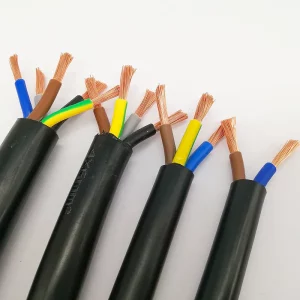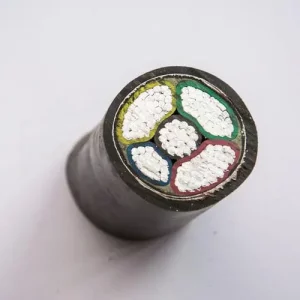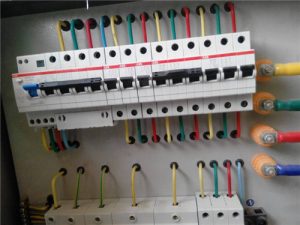In the realm of electrical engineering, the term “three-phase cable” holds significant importance. It is a crucial component in power distribution systems, industrial applications, and various other domains where a reliable and efficient supply of electricity is paramount. In this essay, ZMS vericable will explore what three-phase cables are, delve into their distinctive features, and examine the diverse range of applications in which they play a pivotal role.
What is a Three-Phase Cable?
A three-phase cable, often referred to as a three-core cable, is an electrical cable that comprises three conductors within a single cable assembly. These conductors carry alternating current (AC) signals that are 120 degrees out of phase with each other. This phasing ensures a continuous and smooth flow of power, making three-phase cables particularly suitable for high-power applications.

The three conductors in a three-phase cable are labeled as phase A, phase B, and phase C. Each phase carries an equal magnitude of current, and the phase difference between them facilitates a more efficient transmission of power compared to a single-phase system. The balanced nature of three-phase power distribution results in smoother power delivery and enhanced overall system performance.
Features of Three-Phase Cables
1. Phased Power Distribution
The primary feature that distinguishes three-phase cables is their ability to facilitate phased power distribution. In a three-phase system, each conductor carries an alternating current waveform that reaches its peak at different times. This phased arrangement ensures a continuous and steady supply of power, reducing the likelihood of voltage fluctuations and enhancing the overall stability of the electrical system.
2. Balanced Load Distribution
Three-phase cables contribute to balanced load distribution across the phases. Since the load is distributed evenly among the three conductors, the system operates more efficiently, minimizing the risk of overloading any individual phase. This balance is crucial for preventing equipment damage and optimizing the utilization of the electrical infrastructure.
3. High Power Transmission
Three-phase power systems are renowned for their capacity to transmit high levels of electrical power. The combination of three conductors working in tandem allows for the transmission of a greater amount of power compared to a single-phase system. This feature makes three-phase cables ideal for applications requiring robust power delivery, such as industrial machinery, motors, and large-scale power distribution networks.
4. Three-Phase Cable Reduced Transmission Losses
The balanced nature of three-phase power distribution leads to reduced transmission losses. With the phases working together harmoniously, there is less energy lost as heat during transmission. This efficiency is a critical advantage in power distribution systems where minimizing losses is paramount for sustainability and cost-effectiveness.
5. Versatility in Voltage Levels
Three-phase cables offer versatility in terms of voltage levels. They can be designed to accommodate various voltage requirements, ranging from low voltage for residential applications to high voltage for industrial and commercial settings. This adaptability makes three-phase cables suitable for a wide range of electrical systems.
6. Compatibility with Rotating Machinery
The three-phase power system is inherently well-suited for driving rotating machinery, such as electric motors. The balanced and phased supply of power ensures smooth operation and optimal performance of such machinery, making three-phase cables an integral component in industrial applications.

7. Enhanced Motor Control
Three-phase power is particularly advantageous for motor control applications. The three-phase supply allows for the implementation of complex motor control strategies, contributing to the efficiency and precision of processes in industries like manufacturing, тасымалдау, and robotics.
Applications of Three-Phase Cables
1. Industrial Power Distribution
One of the primary applications of three-phase cables is in industrial power distribution. Industries with high power requirements, such as manufacturing plants and factories. Rely on three-phase power systems to ensure a stable and efficient supply of electricity for operating machinery and equipment.
2. Residential Power Supply
Three-phase power is not limited to industrial use; it is also employed in residential areas, particularly in regions with high electricity demand. Three-phase cables play a role in supplying power to large residential complexes and neighborhoods, ensuring that households receive a reliable and balanced power supply.
3. Commercial Buildings
Commercial buildings, including offices, and shopping malls. And hotels, often utilize three-phase power systems for their electrical needs. This is driven by the need for efficient power distribution to support the diverse range of electrical equipment and systems present in such facilities.
4. Renewable Energy Systems
Three-phase cables are integral components in renewable energy systems, ... қоса алғанда wind and solar power plants. The balanced and high-power transmission capabilities of three-phase systems make them well-suited for efficiently harnessing and distributing energy generated from renewable sources.

5. Electric Motors and Machinery
The compatibility of three-phase power with electric motors makes it a preferred choice for various applications involving machinery. Industries such as manufacturing, тасымалдау, and construction heavily rely on three-phase power for driving motors and ensuring the smooth operation of equipment.
6. HVAC Systems
Heating, ventilation, and air conditioning (HVAC) systems in commercial and industrial buildings often use three-phase power for efficient and reliable operation. The balanced power distribution ensures that HVAC systems can handle the substantial power demands associated with maintaining optimal indoor conditions.
7. Data Centers
In the realm of data centers, where uninterrupted power is critical, three-phase power distribution is commonly employed. Three-phase cables play a crucial role in ensuring that servers and other critical infrastructure receive a consistent and reliable power supply, minimizing the risk of downtime.
8. Transportation Systems
Transportation systems, including railways and airports, frequently use three-phase power for various applications. From providing power to trains and aircraft to supporting infrastructure such as signaling systems and lighting. Three-phase cables contribute to the efficient functioning of transportation networks.
9. Oil and Gas Industry
In the oil and gas industry, where operations often span remote and demanding environments, three-phase power distribution ensures the reliable operation of equipment such as pumps, compressors, and drilling machinery. The robustness of three-phase cables makes them well-suited for such challenging applications.
10. Construction Sites
Construction sites, characterized by the diverse use of heavy machinery and equipment, benefit from the use of three-phase power systems. The ability of three-phase cables to handle high-power requirements is essential for supporting construction activities efficiently.
In conclusion, three-phase cables stand as indispensable components in modern electrical systems, offering a range of features that contribute to efficient power distribution. Their ability to facilitate phased power distribution. Balanced load distribution and high-power transmission make them suitable for a diverse array of applications, from industrial settings to residential neighborhoods. Understanding the features and applications of three-phase cables is essential for ensuring the reliability and sustainability of electrical infrastructure across various domains. As technology continues to advance, the role of three-phase cables in powering our world is poised to become even more integral.